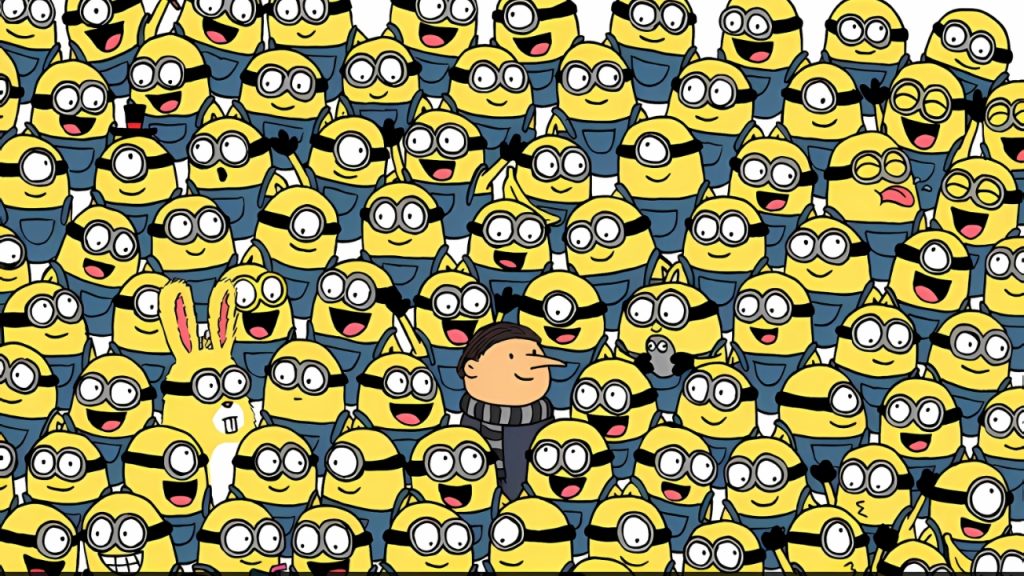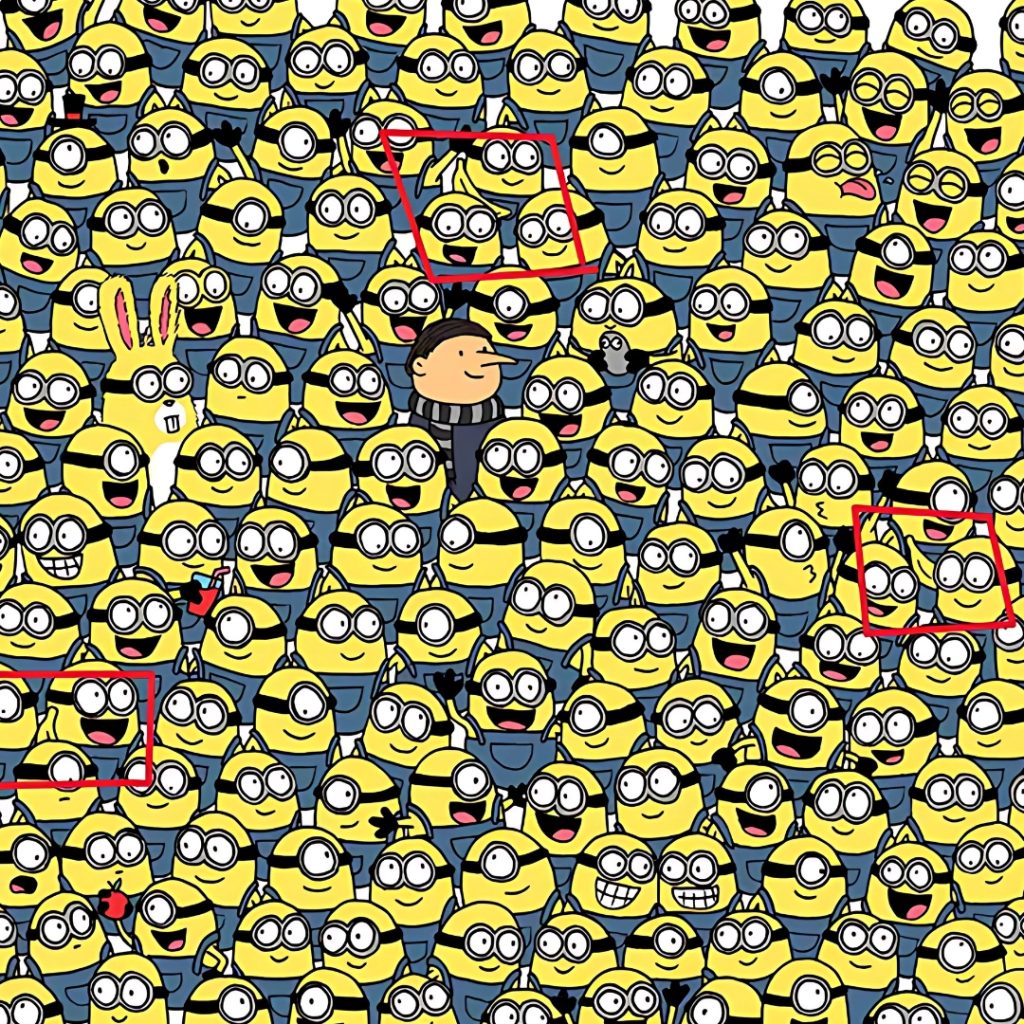Find Three-Second Hidden Bananas Challenge : The human brain processes visual information at an extraordinary rate, yet it can be surprisingly easy to fool.
When you encounter an optical illusion challenge like “Find the Three Hidden Bananas in 3 Seconds,” you’re not just playing a simple game—you’re participating in a complex dance between your eyes, brain, and the fundamental ways we process visual information.
These seemingly simple puzzles reveal profound truths about how our minds work, why we see what we see, and how our brains have evolved to make sense of an incredibly complex visual world.
Understanding the science behind these challenges can help you become better at solving them while also gaining insights into the remarkable machinery of human perception.
The Science Behind Visual Camouflage
When designers create hidden object illusions, they’re exploiting well-documented principles of visual psychology. Our brains have evolved to quickly categorize and process visual information, but this efficiency comes with trade-offs.
We excel at recognizing patterns, detecting movement, and focusing on what seems most important, but we can easily miss details that don’t fit our expectations or that blend seamlessly with their surroundings.
The banana-finding challenge works by using several key principles. First, there’s the concept of figure-ground separation, where our brains must distinguish between the main subject (the bananas) and the background elements. When the bananas are cleverly integrated into a busy visual scene, this natural process becomes much more challenging.
Color matching plays a crucial role in these illusions. Bananas have a distinctive yellow color that our brains typically recognize instantly.
However, when these yellow shapes are placed against backgrounds with similar hues, or when they’re partially obscured by other yellow objects, our automatic recognition systems can fail. The brain might register the yellow as part of the background pattern rather than as distinct objects.

How Your Brain Processes Hidden Objects
Understanding the mechanics of visual processing helps explain why some people excel at these challenges while others struggle. When you look at any image, your brain follows a predictable sequence of operations.
First, your visual cortex processes basic features like edges, colors, and contrasts. Then, higher-level processing areas work to identify shapes, patterns, and objects.
The challenge with hidden object puzzles lies in the fact that your brain wants to process the entire scene as quickly as possible. It makes assumptions and fills in gaps based on previous experience.
When looking for hidden bananas, your brain might initially process the image as a coherent whole—perhaps a fruit bowl, kitchen scene, or tropical landscape—without examining every individual element carefully.
This is where the three-second time limit becomes particularly interesting from a scientific perspective. Research in cognitive psychology suggests that rapid visual processing happens in distinct phases.
The first few hundred milliseconds involve basic feature detection, while more complex object recognition typically requires one to three seconds.
By imposing a three-second limit, these challenges are essentially asking you to bypass your brain’s natural tendency toward comprehensive scene analysis and instead engage in targeted, strategic searching.
Strategies for Success: Training Your Visual Attention
Becoming proficient at hidden object challenges requires developing specific visual attention skills. Rather than letting your eyes wander randomly across the image, successful searchers employ systematic strategies that work with, rather than against, their brain’s natural processing tendencies.
One effective approach involves understanding how attention spreads across visual scenes. Research shows that we tend to focus on areas of high contrast, unusual shapes, or elements that break expected patterns.
When searching for hidden bananas, look first for areas where the characteristic banana shape might be outlined against contrasting backgrounds, even if the colors blend together.
The scanning pattern you use makes a significant difference in success rates. Many people instinctively start in the center of an image and work outward, but this isn’t always optimal.
Professional searchers often use systematic grid patterns, dividing the image into sections and examining each area thoroughly before moving on. This prevents the common problem of repeatedly scanning the same areas while missing others entirely.
Another powerful technique involves changing your mental focus. Instead of looking for complete banana shapes, train yourself to spot banana-like curves, the distinctive tapering form, or even just the right proportion of yellow in the right configuration.
Our brains are remarkably good at pattern completion—once you spot part of a hidden object, the rest often becomes visible almost instantly.
The Psychology of Pattern Recognition
The reason hidden object illusions work so effectively ties into fundamental aspects of how pattern recognition evolved in humans. Our ancestors needed to quickly identify both opportunities and threats in complex natural environments.
This evolutionary pressure created brains that excel at rapid categorization but can be fooled when familiar objects appear in unexpected contexts.
When bananas are hidden in plain sight, they often violate our expectations about where such objects should appear. We expect to see bananas in fruit bowls, grocery stores, or tropical settings.
When they appear integrated into architectural elements, camouflaged against foliage that matches their color, or positioned in ways that break their familiar silhouette, our pattern recognition systems need more time and conscious effort to identify them.
This explains why practice significantly improves performance on these challenges. As you encounter more hidden object puzzles, your brain builds a broader library of potential contexts and camouflage strategies.
You become better at suppressing your initial, automatic interpretations of scenes and engaging the more deliberate, analytical visual processing systems.
The Role of Individual Differences
Not everyone approaches visual puzzles in the same way, and understanding these individual differences can help you optimize your own strategy. Some people naturally employ more systematic, analytical approaches to visual processing, while others rely more heavily on intuitive, holistic pattern recognition.
Age plays a fascinating role in hidden object performance. While younger individuals often have faster processing speeds, older adults frequently demonstrate superior strategies and persistence. This suggests that experience and learned approaches can compensate for changes in raw processing speed.
Visual training and professional background also influence performance significantly. People who work in fields requiring careful visual attention—such as radiologists, quality control inspectors, or graphic designers—often excel at these challenges. Their brains have developed enhanced abilities to spot subtle anomalies and patterns within complex visual information.
The Broader Impact of Visual Challenge Training
Engaging regularly with hidden object illusions and similar visual challenges may provide benefits beyond simple entertainment. Research in cognitive training suggests that systematic practice with visual attention tasks can improve overall observational skills and may even help maintain cognitive sharpness as we age.
These exercises specifically target several important cognitive functions. Visual scanning skills improve through regular practice, as does the ability to maintain focused attention despite distracting elements. The process of searching for hidden objects also exercises working memory, as you must remember which areas you’ve already examined while processing new visual information.
Perhaps most importantly, these challenges help develop metacognitive awareness about your own visual processing tendencies. As you become more conscious of how your eyes and brain typically approach visual scenes, you can learn to deliberately employ alternative strategies when needed.
Optical Illusion Answer

Mastering the Three-Second Challenge
The specific demand of finding three hidden bananas within three seconds creates a unique cognitive challenge that combines speed, accuracy, and strategic thinking. Success requires immediately recognizing that a systematic approach is necessary while simultaneously executing that approach with remarkable efficiency.
The key lies in preparation and pattern recognition. Before even starting the timer, take a moment to consider where bananas might logically be hidden. Are there areas of yellow that could camouflage them? Are there organic shapes that might incorporate banana silhouettes? Are there obvious locations where a puzzle designer might place objects to create satisfying “aha” moments?
Once you begin searching, resist the temptation to focus too intensely on any single area. The three-second limit requires broad, efficient scanning rather than detailed examination. Train your peripheral vision to notice banana-like shapes while your central vision systematically moves across the image.
Remember that finding one banana often makes the others more visible. Puzzle designers frequently use similar camouflage strategies for multiple hidden objects, so once you identify the method for one banana, quickly scan for similar patterns elsewhere in the image.
The Future of Visual Perception Research
Hidden object illusions continue to provide valuable insights for researchers studying visual perception, attention, and cognitive processing. As our understanding of these mechanisms deepens, we’re discovering new applications in fields ranging from medical imaging to artificial intelligence development.
These simple puzzles connect to cutting-edge research in computer vision, where scientists work to create artificial systems that can identify objects in complex visual scenes. The challenges that make hidden object illusions difficult for humans—camouflage, context violations, and attention management—are equally challenging for computer systems.
The enduring popularity of these visual challenges speaks to something fundamental about human curiosity and the satisfaction we derive from solving perceptual puzzles.
Whether you find all three bananas in three seconds or need a bit more time, you’re participating in a form of cognitive exercise that has entertained and educated people for generations while contributing to our ongoing understanding of one of the most sophisticated information processing systems ever evolved: the human visual system.
By understanding the science behind these illusions, you transform a simple game into an opportunity for learning about perception, attention, and the remarkable capabilities of your own mind. The next time you encounter a hidden object challenge, you’ll be equipped not just with strategies for success, but with a deeper appreciation for the complex and fascinating process of human vision itself.
